In Their Own Words: The Front Lines of the 1918 Influenza Pandemic

- New AI-Technology Estimates Brain Age Using Low-Cost EEG Device
- Bolstered by Research Consortium with Drexel, Jefferson’s Sidney Kimmel Cancer Center Earns NCI Comprehensive Cancer Center Designation
- Drexel’s Pearlstein Gallery Offers Spring Exhibitions Centered on the Healing Properties of Art and Creative Works
- Pinging Pipes Could Help to Identify Lead Water Lines Without Excavation
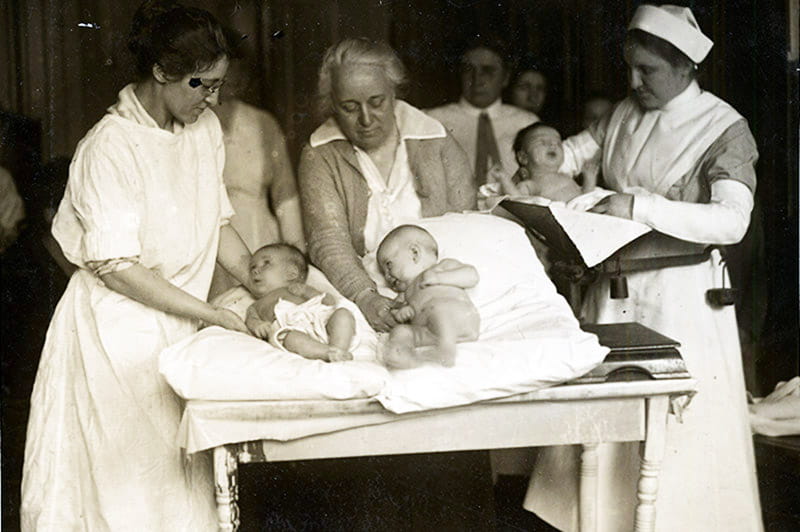
Please visit the ‘Drexel’s Response to Coronavirus’ website for the latest public health advisories.
The Woman’s Medical College of Pennsylvania (WMCP), the world’s first degree-granting women’s medical school and a predecessor medical institution of Drexel University’s College of Medicine, was already weakened by World War I when the influenza pandemic hit Philadelphia in the fall of 1918. Handicapped by decreased faculty numbers, WMCP was also under new leadership — longtime faculty member and alumna Martha Tracy, MD 1904, became dean in 1917 — and it was stretched in staffing the Hospital of the Woman’s Medical College of Pennsylvania (also referred to as “College Hospital” and “Main Hospital”) in North Philadelphia and its Barton Dispensary, which provided free medical and surgical services to the poor and was located in South Philadelphia. WMCP staff and alumnae also treated patients at the nearby Woman’s Hospital of Philadelphia (which didn’t belong to WMCP even though WMCP staff worked there).
WMCP faculty, staff and students were involved in the 1918 influenza pandemic in Philadelphia from the very start. The Woman’s Hospital began treating influenza patients on Sept. 18, the same day the city reported its first diagnosed case. By Sept. 23, the College Hospital had cleared out as many rooms as possible for incoming patients. By Sept. 30, two days after Philadelphia held its doomed Liberty Loan parade, WMCP had cancelled classes so faculty, staff and students could treat patients. By early October, the Barton Dispensary closed and the College Hospital created an emergency hospital at the Southwark Neighborhood House in southeastern Philadelphia. Normal academic life didn’t resume at WMCP until the end of October.
What was that experience like for WMCP faculty, staff and students during those horrible weeks? That’s hard to say.

The Legacy Center Archives at the Drexel University College of Medicine, which is the repository for WMCP records and history, has records from that time period. But what few records remain or were even created (and, also, can be accessed remotely during the COVID-19 pandemic) are mostly reports, articles and speeches from WMCP faculty and staff months after the events they describe.
“Looking across 1910–1930, we generally have few day-to-day practice-of-medicine records in the Legacy Center, so it follows a ‘recordkeeping as usual’ logic that we wouldn’t have these types of records from 1918–1919,” said Archivist Matt Herbison. “But at the same time, it’s surprising that we don’t have more, considering it was a really huge deal! My own conjecture is that it would have taken extra, and deliberate, effort to create records and hold onto them during the height of the crisis, but that was exactly the time when they were inundated with patients and probably had much bigger concerns.”
In the midst of the COVID-19 pandemic a little more than a century later, it’s easy to look back at the 1918 pandemic to make comparisons. For example, the Legacy Center’s Public History Virtual Intern Ari McManus, a graduate student at Temple University, recently wrote a blog post, “Woman’s Medical College vs. The 1918 Flu Pandemic,” summarizing the 1918 global pandemic, how it unfolded in Philadelphia and the role WMCP played in treating influenza patients during that time.
That blog post serves as an informative and useful companion piece to this article, in which DrexelNow shares some recollections of those WMCP faculty and staff — all women, and most of them WMCP alumnae — as recorded in their own words. Please note that the quotes below are lightly edited, with original spelling, grammar and capitalization intact.
Early Days of the Pandemic
Martha Tracy, MD 1904, dean of WMCP and member of the Alumnae Association of WMCP, at the 44th Annual Meeting of the Alumnae Association of WMCP in June 1919: “In September, after one week of college work, the epidemic of influenza, like a specter of death, was upon us almost overnight, and three days after the disease was made reportable by the Board of Health our hospital was full to overflowing with victims of the pestilence, and our Senior, Junior and Sophomore students were released from class work and mobilized for hospital service.
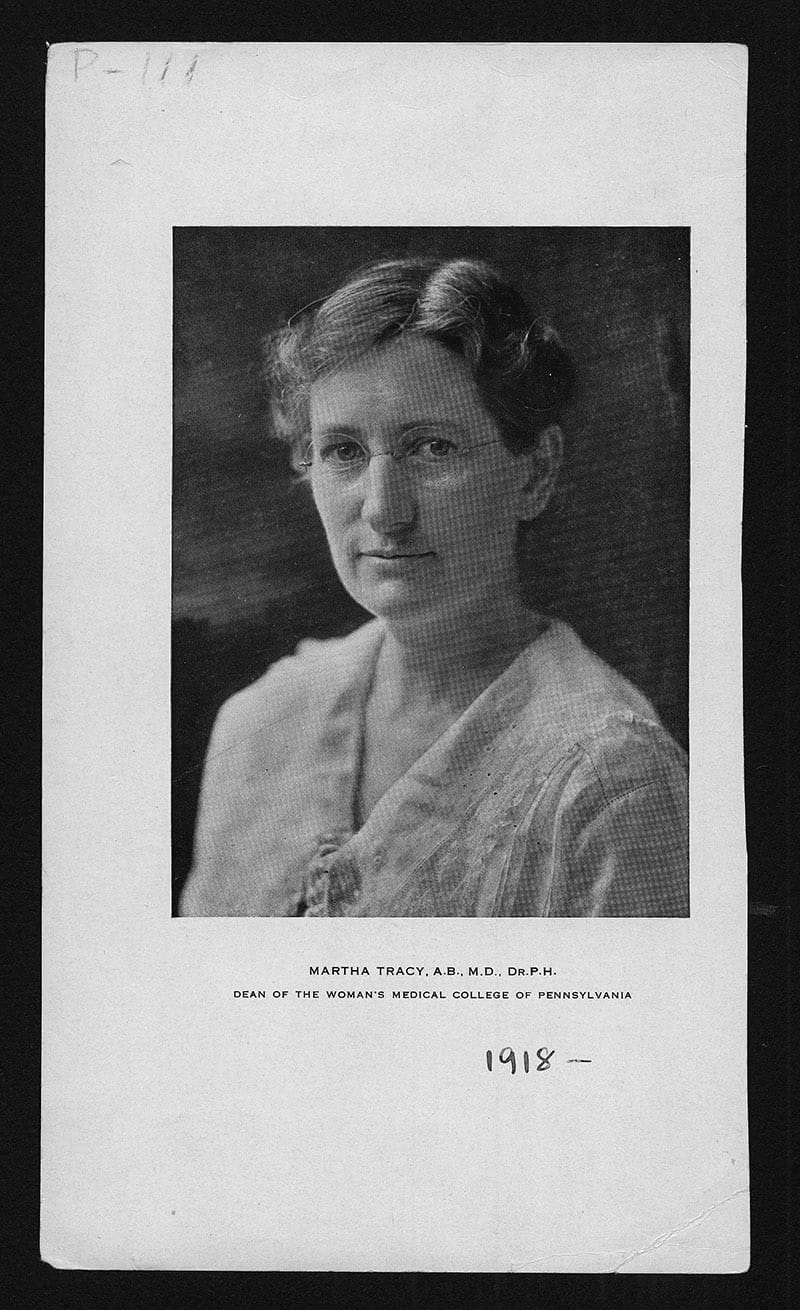
“Within a week our gymnasium became a hospital ward, where students and nurses who succumbed while serving on the battle front were cared for. A week later, at the request of the Sun Shipbuilding Company, we provided the medical and nursing staff for an emergency ward equipped by this company at the Southwark Settlement House.”
Unknown Author, “Bulletin of the Woman’s Medical College of Pennsylvania,” Vol. 69, December 1918: “During the third week in September, at the first suggestion of an impending epidemic, the College Hospital began to adjust its organization to meet the coming need. The first step consisted in emptying the wards of convalescent patients, and this was done as rapidly as possible, so that by September 23, we were ready to meet the influx of new cases.
“It was truly like unto the rush of the wounded from the field of battle, and the house was filled to capacity almost at once. Within a few days it was necessary to open a ward in the College gymnasium, which was equipped with beds from our students’ dormitory, the ambulance gathering both the beds and the patients and bringing them into the hospital….Sheets, lent by the Red Cross, played the role of curtains and table covers; stools, dedicated to the sacred precincts of…laboratories, served as bedside tables; and with the exception of Miss Pepper, who was the commanding officer, the nurses were merely camouflaged medical students.”
Anne H. Thomas, MD 1905, WMCP clinical lecturer in the practice of medicine and clinician of medicine, medical staff member of the Woman’s Hospital of Philadelphia and member of Alumnae Association of WMCP, at the 44th Annual Meeting of the Alumnae Association of WMCP in June 1919: “The first case was admitted to the Woman’s Hospital on September 18, 1918….This was a young woman, eight months pregnant, with the irregular signs of pneumonia, which we all have since learned to recognize only too well, but which were then unfamiliar to many of us….The patient was isolated and precautions taken to prevent the spread of the disease. A second case was admitted three days later, also pregnant (seven months) and also with pneumonia. Within the week, several nurses were sent to bed with symptoms of influenza, and during the next six weeks, between thirty-five and forty cases of influenza were admitted to the hospital. As rapidly as possible the patients then in the hospital were sent home, and by October 1 the ward was available for epidemic cases.”
Fall 1918 By the Numbers
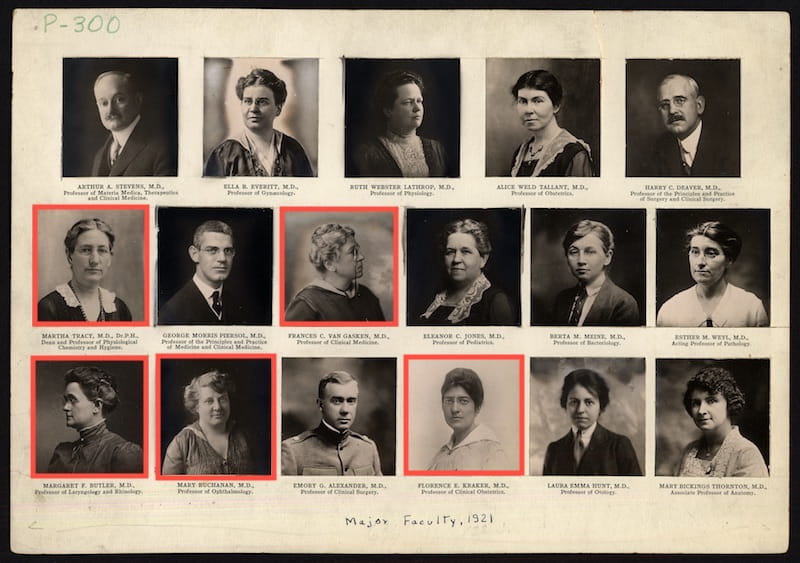
Unknown Author, “Bulletin of the Woman’s Medical College of Pennsylvania,” Vol. 69, December 1918: “Remembering that we are a 100-bed hospital, the number of patients whom we served in this emergency is of considerable interest. We received at the Main Hospital 265 patients and a tour Southwark Emergency 75; there were 42 births at the Main Hospital — making a total of house patients of 382. In addition, on the out-practice we delivered 36 women of 36 infants and the Medical Out-practice cared for 104 patients in their homes, giving us a total of 548 patients cared for.
“We had 71 deaths to report, the usual large number of Coroner’s cases being included among these, a mortality rate for the number of treated, of 12.9 per cent. When we consider the conditions under which many of the patients were brought to us…I believe that we have done better than could have been expected.”
“During the period of the epidemic our [social] worker and her volunteer helpers made a total of 225 visits on 105 families, 228 individuals.”
Martha Tracy, MD 1904, dean of WMCP, at the 44th Annual Meeting of the Alumnae Association of WMCP in June 1919: “We record with thankfulness that we lost no one of our doctors or students in that battle, and with sorrow, that one faithful nurse laid down her life on the field of duty.”
Caring for the Community
Meta Jones, WMCP’s chief social worker, unknown date: “So numerous and so urgent were the pleas of physicians that the Barton Out-Practice was unable to meet the demands, and the Social Service [Department] visited with and for the doctors. Entire families were prostrate, neighbors were terrified and there was no one to help.
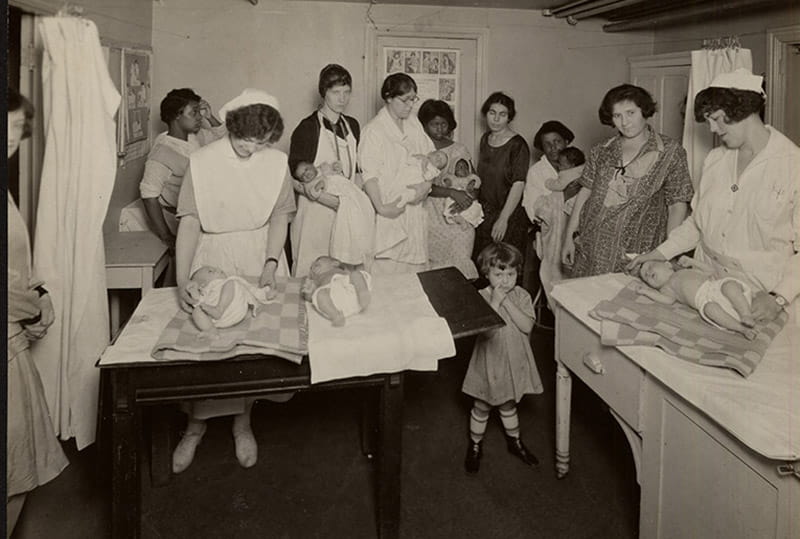
“The caring for the seriously ill in the home was impracticable, the hospitals were overcrowded, and patients were compelled to wait days for admission to the hospitals and then were carried long distances in uncomfortable conveyances. There was a crying need for a hospital in the immediate neighborhood, and through the cooperation of the Southwark Neighborhood House, the Sun Shipbuilding Company and the College Settlement, an Emergency Hospital was opened, early in October, under the care of the Hospital of the Woman’s Medical College of Pennsylvania. The scarcity of doctors made it necessary to close the Barton Out-Practice, and to carry the patients into the Emergency Hospital. The Social Service helped to put the hospital equipment in order, visited hospital daily for food, drug orders and other requisites.”
Unknown Author, “Bulletin of the Woman’s Medical College of Pennsylvania,” Vol. 69, December 1918: “If the work at the main hospital was strenuous and heart-breaking, the work at the ‘front,’ meaning Front and Ellsworth Streets, where our emergency ward was established, brought us very close to the realities of war….Our Social Service worker, Miss Jones, at the onset of the epidemic brought us into relation with the other social service forces of the neighborhood….As our medical staff gave service in the homes, she, with her workers, carried food prepared at the settlement to the patients needing it. And the “clean-up squads” were on the road close after the food squads, making the homes more habitable for the sick and well. All this was undertaken before the epidemic had assumed large proportions.”
Students Jump in to Help
Unknown Author, “Bulletin of the Woman’s Medical College of Pennsylvania,” Vol. 69, December 1918: “During the weeks, September 30 to October 22, all class work of the senior, junior, and sophomore students was omitted, and the students mobilized for hospital work during the influenza epidemic. To the first-year students belongs the credit for keeping the College machinery running, which they did faithfully, even resisting the inroads of the influenza germ….There was rejoicing in all classes when it was possible to return to our normal academic life late in October.”
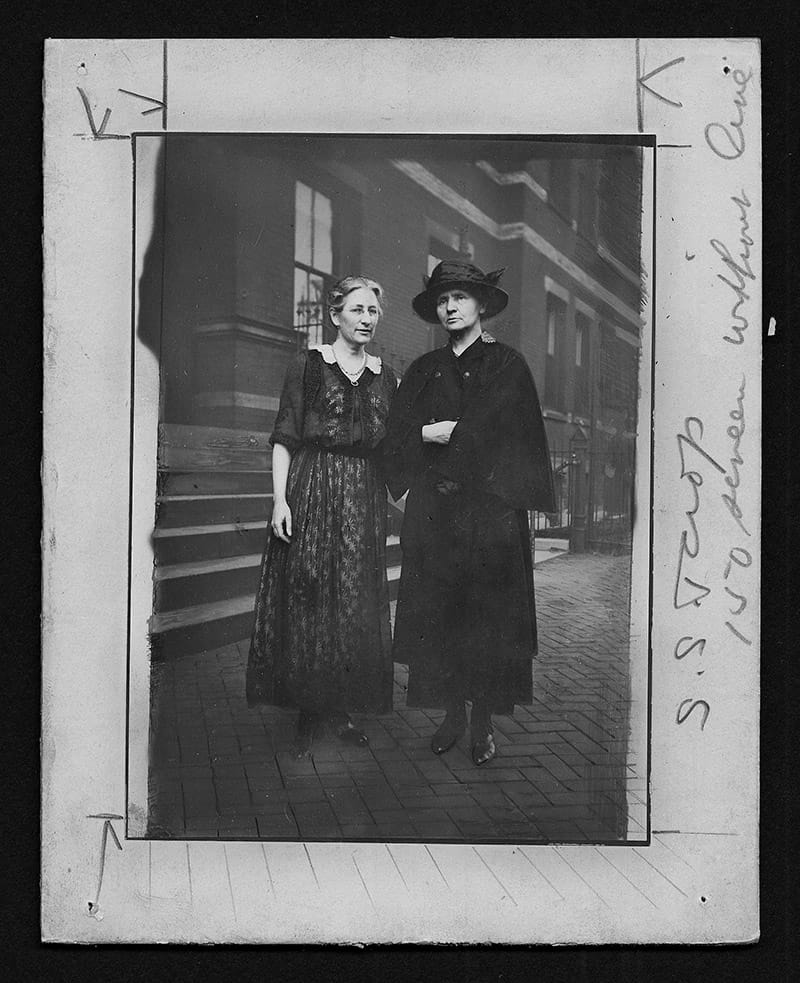
Martha Tracy, MD 1904, dean of WMCP, at the 44th Annual Meeting of the Alumnae Association of WMCP in June 1919: “During the epidemic the Freshman class of thirty students…stood by to give assistance or relief to the first line whenever it was asked.
“Owing to the loss of time from class work during those weeks it seemed advisable, and indeed necessary, to extend the College session and defer Commencement Day until June 18.”
Remembering the Work of Volunteers
Unknown Author, “Bulletin of the Woman’s Medical College of Pennsylvania,” Vol. 69, December 1918: “We believe the successful resistance to the infection shown by the majority of our nurses to be due to the kindly offices of the Cynwyd Chapter of the Red Cross and other friends who sent automobiles each night to give the tired nurses and students an hour of fresh air without exertion.”
“The ambulance, the elevator, the laundry, with all its complicated machinery, were run by women previously untrained to the task. A YWCA secretary became the good right hand of the dietician. Ladies untrained in hospital detail displayed equal willingness and capacity in washing dishes and in bathing babies; an expert bookkeeper helped to keep the records up-to-date; young medical students became our most relied-upon night nurses; laboratory physicians became practitioners of medicine for the period of the emergency; probationer nurses, hardly twenty-four hours old in the profession, worked most dependably throughout the trying days; and women who had never been called upon for hard work did a full day’s hard labor day after day.”
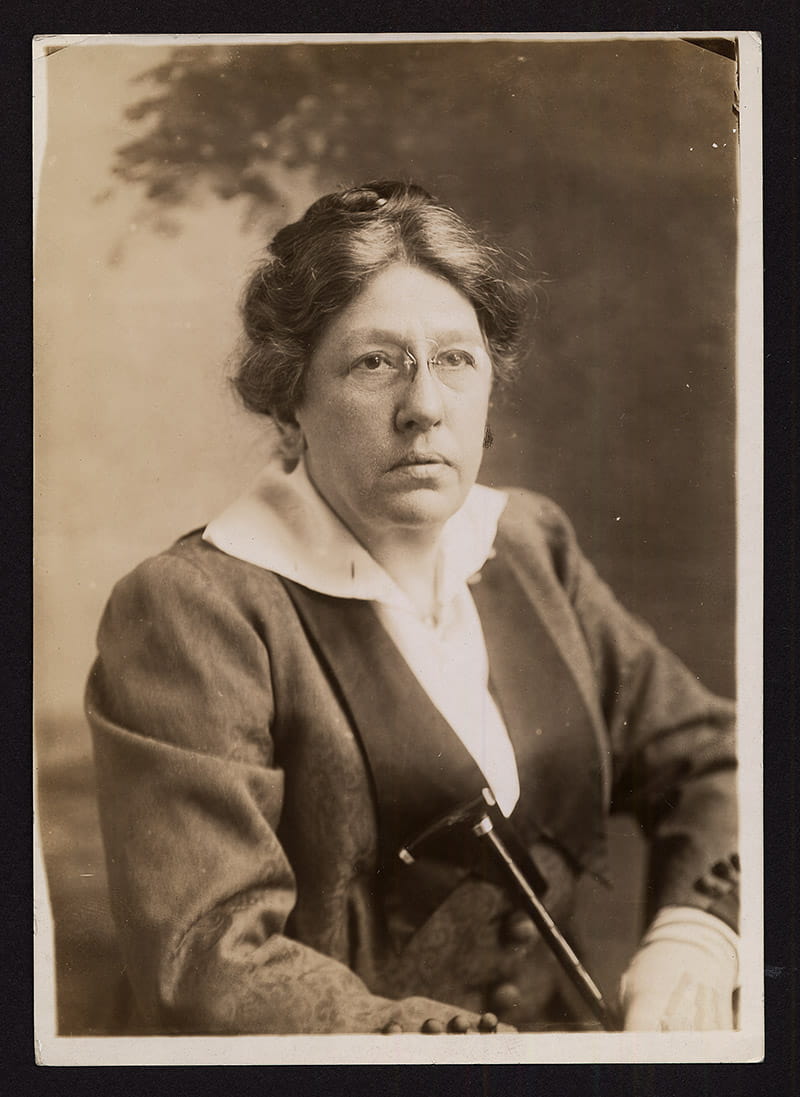
Heroic Work from the Front Line
Florence E. Kraker, MD 1905, acting obstetrician-in-chief at the WMCP Hospital, WMCP clinical professor of obstetrics and member of Alumnae Association of WMCP, date unknown: “During the influenza epidemic, because of the extreme susceptibility of pregnant women, it was felt to be safer not to admit patients having the disease to the maternity. All cases of influenza complicating pregnancy were taken into the main hospital. In this way we maintained our maternity free from the infection, and so were able to offer a safe place in which our patients could have their babies.”
Unknown Author, “Bulletin of the Woman’s Medical College of Pennsylvania,” Vol. 69, December 1918: “Our regular supervising nurses were fortunately not attacked by the influenza, so that we were able to depend upon them for direction of the uninitiated, and our pupil nurses gave unending service, day and night, often one junior nurse being the most experienced person in charge of her ward.”
“In addition to the work done in the hospitals proper, our Chief, Dr. [Frances C.] Van Gasken [MD 1890, WMCP professor of clinical medicine; acting physician-in-chief of College Hospital; staff member of medicine at the Woman’s Hospital of Philadelphia; and 1916 President and member of the Alumnae Association of WMCP), gave generously of her time in house-to-house visits in the northern part of the city, and associated with her, for long or short periods, were Dr. [Martha] Tracy, Dr. [Caroline] Croasdale [MD 1914, 1918 corresponding secretary of the Alumnae Association of WMCP], and Dr. [Marnetta E.] Vogt [MD 1916], together with two of our senior students….Dr. [Margaret F.] Butler [MD 1894, WMCP clinical professor of laryngology and chief of the Nose and Throat Department of the WMCP Hospital and 1908 President and life member of the Alumnae Association of WMCP]…gave devoted service in the wards of the Main Hospital and at Southwark, besides carrying on a very large volume of charity work throughout the city and suburbs.”

Mary Buchanan, MD 1899, clinical professor of ophthalmology at WMCP, ophthalmology medical staff member at the Woman’s Hospital of Philadelphia and 1917 and 1918 president of the Alumnae Association of WMCP, at the 44th Annual Meeting of the Alumnae Association of WMCP in June 1919: “The scarcity of doctors and the dearth of nurses threw an awful burden on those left in civil life. The acts of heroism of some of our women doctors will never be known, but the devotion to duty while those nearest and dearest to them were dying and dead, too far away for them to reach them, was worthy of an epic I am unable to write. Even as her poor tired heart seemed as if it could not stand the added strain of the death of two dear brothers the same day of the dread plague, one brave doctor said she would be willing to die if she were able to save the mother of eight children who had aborted and had pneumonia. Fortunately her own life did not pay the penalty and the children were not orphans. Another lost a brother and his bride came and demanded work in the hospital to help forget. Another whose fiancé was one of the first victims, pitched right in to save hundreds of patients when the entire medical staff was laid low.”
Martha Tracy, MD 1904, dean of WMCP, at the 44th Annual Meeting of the Alumnae Association of WMCP in June 1919: “It is unnecessary to dwell on the nightmare of the five weeks which followed [the start of the pandemic]. You know how our doctors and students, with no thought of self, labored day and night in that death struggle, and members of our Board of Corporators stood with them, daily serving as nurses’ aides, dieticians or clerks, wherever the need was greatest.”
In This Article
Drexel News is produced by
University Marketing and Communications.
